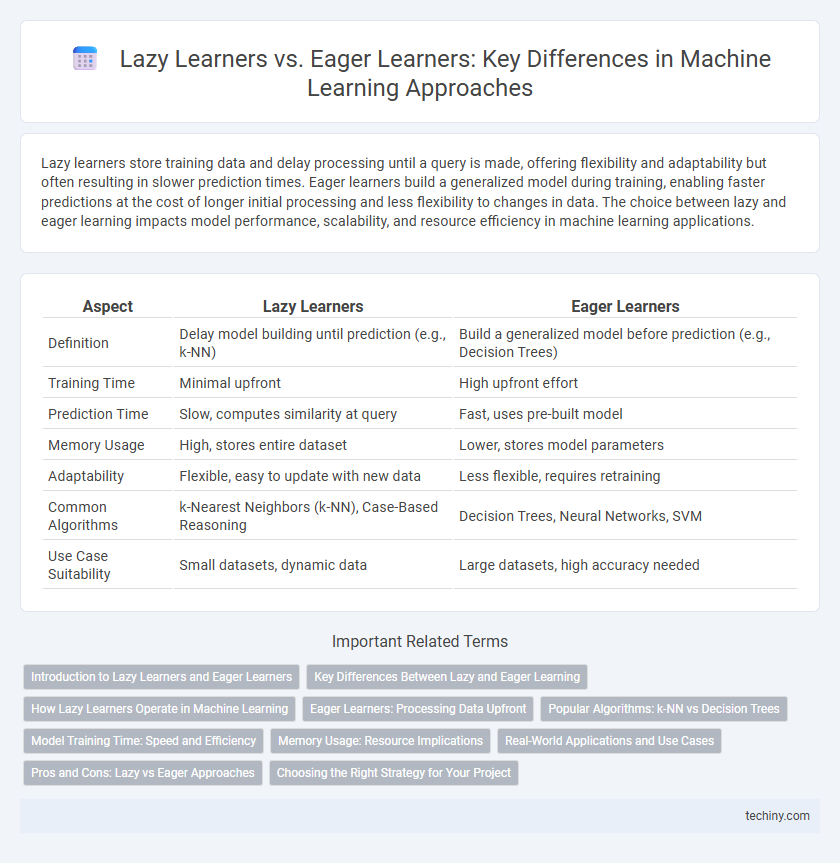Lazy learners store training data and delay processing until a query is made, offering flexibility and adaptability but often resulting in slower prediction times. Eager learners build a generalized model during training, enabling faster predictions at the cost of longer initial processing and less flexibility to changes in data. The choice between lazy and eager learning impacts model performance, scalability, and resource efficiency in machine learning applications.
Table of Comparison
| Aspect | Lazy Learners | Eager Learners |
|---|---|---|
| Definition | Delay model building until prediction (e.g., k-NN) | Build a generalized model before prediction (e.g., Decision Trees) |
| Training Time | Minimal upfront | High upfront effort |
| Prediction Time | Slow, computes similarity at query | Fast, uses pre-built model |
| Memory Usage | High, stores entire dataset | Lower, stores model parameters |
| Adaptability | Flexible, easy to update with new data | Less flexible, requires retraining |
| Common Algorithms | k-Nearest Neighbors (k-NN), Case-Based Reasoning | Decision Trees, Neural Networks, SVM |
| Use Case Suitability | Small datasets, dynamic data | Large datasets, high accuracy needed |
Introduction to Lazy Learners and Eager Learners
Lazy learners store training data without building an explicit model, deferring generalization until a query is made, exemplified by algorithms like k-Nearest Neighbors. Eager learners construct a general model during training, such as decision trees or neural networks, enabling faster predictions but requiring significant upfront computation. Understanding the trade-offs between lazy and eager learning approaches is critical for selecting appropriate machine learning algorithms based on data size and query latency requirements.
Key Differences Between Lazy and Eager Learning
Lazy learners, such as k-Nearest Neighbors, delay the generalization process until a query is made, storing training data without creating an explicit model, resulting in slower prediction times but faster training. Eager learners, like decision trees or neural networks, build a generalized model during training, enabling quicker predictions but requiring more computational resources upfront. Key differences include training duration, prediction speed, model complexity, and adaptability to new data, where lazy learners excel in dynamic environments and eager learners perform better in static scenarios.
How Lazy Learners Operate in Machine Learning
Lazy learners in machine learning operate by deferring the generalization process until a query is made, storing the training data without building an explicit model. They perform computation only at prediction time, comparing new instances to stored examples using similarity metrics such as Euclidean distance or Manhattan distance. This approach enables flexible, instance-based learning but often results in higher latency during inference compared to eager learners.
Eager Learners: Processing Data Upfront
Eager learners construct a generalized model by processing the entire training dataset upfront, enabling faster predictions during deployment. Algorithms such as decision trees, neural networks, and support vector machines exemplify eager learning by abstracting patterns before receiving query inputs. This upfront computation often results in improved efficiency and accuracy when handling large-scale or complex data environments.
Popular Algorithms: k-NN vs Decision Trees
k-Nearest Neighbors (k-NN) exemplifies lazy learning by storing training data and deferring computation until prediction, enabling flexible adaptation but increased query time. Decision Trees represent eager learners by constructing a model during training through recursive partitioning of feature space, resulting in fast prediction and interpretability. Both algorithms excel in different scenarios: k-NN is effective for small datasets with complex patterns, while Decision Trees perform well on large datasets and facilitate feature importance analysis.
Model Training Time: Speed and Efficiency
Lazy learners, such as k-Nearest Neighbors, have minimal model training time since they defer processing until prediction, resulting in faster initial setup but slower query responses. Eager learners, like decision trees and support vector machines, require intensive training upfront, building generalized models that enable rapid and efficient predictions later. This trade-off influences the choice of algorithm based on application needs for speed and computational resource allocation during model development versus inference.
Memory Usage: Resource Implications
Lazy learners such as k-Nearest Neighbors store the entire training dataset, resulting in high memory usage and increased storage requirements. Eager learners like Decision Trees compress training data into a model, leading to lower memory consumption during prediction. The choice between lazy and eager learners impacts resource allocation, influencing scalability in large-scale machine learning applications.
Real-World Applications and Use Cases
Lazy learners like k-Nearest Neighbors excel in real-time recommendation systems and anomaly detection due to their instance-based learning and adaptability to dynamic data. Eager learners such as Support Vector Machines and Neural Networks are preferred in image recognition, natural language processing, and large-scale predictive modeling because of their faster prediction times and ability to generalize from training data. Industries including finance, healthcare, and e-commerce leverage these models to balance accuracy, computational efficiency, and scalability based on specific application requirements.
Pros and Cons: Lazy vs Eager Approaches
Lazy learners, such as k-Nearest Neighbors, excel in flexibility and adapt well to complex data without requiring extensive training, but they suffer from high prediction latency and storage costs due to deferred computation. Eager learners, including decision trees and neural networks, offer faster prediction times and can generalize patterns effectively after training, though they demand significant computational resources upfront and face risks of overfitting. Selecting between lazy and eager approaches depends on application-specific factors like dataset size, real-time prediction needs, and available processing power.
Choosing the Right Strategy for Your Project
Lazy learners, like k-Nearest Neighbors, store training data and delay generalization until a query is made, making them ideal for projects requiring adaptive models with minimal upfront training. Eager learners, such as decision trees and neural networks, build a comprehensive model during training, offering faster predictions suited for applications with fixed, well-defined tasks. Selecting the right strategy depends on factors like dataset size, computational resources, prediction speed, and the need for model interpretability in your machine learning project.
Lazy Learners vs Eager Learners Infographic

 techiny.com
techiny.com